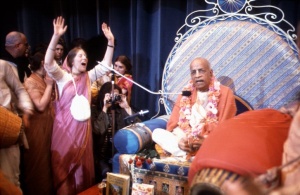CC Madhya 6.190 (1975): Difference between revisions
(Vanibot #0027: CCMirror - Mirror CC's 1996 edition to form a basis for 1975) |
(Vanibot #0020: VersionCompareLinker - added a link to the Version Compare feature) |
||
| Line 2: | Line 2: | ||
<div style="float:left">'''[[Sri Caitanya-caritamrta (1975)|Śrī Caitanya-caritāmṛta (1975)]] - [[CC Madhya (1975)|Madhya-līlā]] - [[CC Madhya 6 (1975)|Chapter 6: The Liberation of Sārvabhauma Bhaṭṭācārya]]'''</div> | <div style="float:left">'''[[Sri Caitanya-caritamrta (1975)|Śrī Caitanya-caritāmṛta (1975)]] - [[CC Madhya (1975)|Madhya-līlā]] - [[CC Madhya 6 (1975)|Chapter 6: The Liberation of Sārvabhauma Bhaṭṭācārya]]'''</div> | ||
<div style="float:right">[[File:Go-previous.png|link=CC Madhya 6.189 (1975)|Madhya-līlā 6.189]] '''[[CC Madhya 6.189 (1975)|Madhya-līlā 6.189]] - [[CC Madhya 6.191 (1975)|Madhya-līlā 6.191]]''' [[File:Go-next.png|link=CC Madhya 6.191 (1975)|Madhya-līlā 6.191]]</div> | <div style="float:right">[[File:Go-previous.png|link=CC Madhya 6.189 (1975)|Madhya-līlā 6.189]] '''[[CC Madhya 6.189 (1975)|Madhya-līlā 6.189]] - [[CC Madhya 6.191 (1975)|Madhya-līlā 6.191]]''' [[File:Go-next.png|link=CC Madhya 6.191 (1975)|Madhya-līlā 6.191]]</div> | ||
{{CompareVersions|CC|Madhya 6.190|CC 1975|CC 1996}} | |||
{{RandomImage}} | {{RandomImage}} | ||
==== TEXT 190 ==== | ==== TEXT 190 ==== | ||
| Line 11: | Line 10: | ||
<div class="verse"> | <div class="verse"> | ||
:nava-vidha artha kaila śāstra-mata lañā | :nava-vidha artha kaila śāstra-mata lañā | ||
: | :śuni' prabhu kahe kichu īṣat hāsiyā | ||
</div> | </div> | ||
| Line 18: | Line 17: | ||
<div class="synonyms"> | <div class="synonyms"> | ||
nava-vidha—nine kinds; artha—meanings; kaila—did; śāstra-mata—the principles of authorized scriptures; lañā—taking; | nava-vidha—nine kinds; artha—meanings; kaila—did; śāstra-mata—the principles of authorized scriptures; lañā—taking; śuni'-after hearing that; prabhu—Lord Caitanya; kahe—began to speak; kichu—something; īṣat—slightly; hāsiyā—smiling. | ||
</div> | </div> | ||
Latest revision as of 18:42, 27 January 2020

A.C. Bhaktivedanta Swami Prabhupada
TEXT 190
- nava-vidha artha kaila śāstra-mata lañā
- śuni' prabhu kahe kichu īṣat hāsiyā
SYNONYMS
nava-vidha—nine kinds; artha—meanings; kaila—did; śāstra-mata—the principles of authorized scriptures; lañā—taking; śuni'-after hearing that; prabhu—Lord Caitanya; kahe—began to speak; kichu—something; īṣat—slightly; hāsiyā—smiling.
TRANSLATION
The Bhaṭṭācārya explained the ātmārāma verse in nine different ways on the basis of scripture. After hearing his explanation, Śrī Caitanya Mahāprabhu, smiling a little, began to speak.
PURPORT
The ātmārāma verse was discussed at Naimiṣāraṇya at a meeting of many great sages, headed by Śaunaka Ṛṣi. They questioned Śrīla Sūta Gosvāmī, who presided at the meeting, about why Śrīla Śukadeva Gosvāmī, a paramahaṁsa already in the transcendental position, was attracted to a discussion of the qualities of Kṛṣṇa. In other words, they wanted to know why Śrī Śukadeva Gosvāmī engaged in the study of Śrīmad-Bhāgavatam.